Pillars of Creation
Romantic astronomer Professor Carl Sagan, best known as the author of the Book of the Universe, has spent his entire life trying to bridge the gap between astronomy and the public. The Hubble Space Telescope can also be cited as another entity that made astronomy known to the public along with his dedication.
Even the public, who were not interested in astronomy, became interested in the colorful universe photographed by the Hubble Space Telescope and began collecting astronomy photos.
Among these are the Pillars of Creation, known to be one of the most famous and beautiful photographs. The Pillar of Creation is part of the Eagle Nebula, also known as Messier 16 (M16), literally the “cradle of the stars” from which innumerable celestial bodies are born.
Pillars of Creation ⓒ Hubble Space Telescope / NASA
The image above was taken in 1995 by astronomers Dr. Jeff Hester and Dr. Paul Squeen of Arizona State University at the time, and it was discovered that they were forming a new star.
On the other hand, hot ultraviolet light and stellar winds from young stars have been shown to slowly erode the constellations of gas and dust. It was later voted one of the 10 best images of the Hubble telescope.
The Pillars of Creation were made with another telescope
In 2011, several space telescopes, such as the European Space Agency’s Herschel Space Observatory using mid-infrared wavelengths, the XMM-Newton telescope using X-rays, and the upgraded Hubble Space Telescope, reinvented the Pillars of the Creation.
Pillar of Creation, taken with the Herschel Space Telescope (bottom center) ⓒ Herschel Space Observatory / European Space Agency
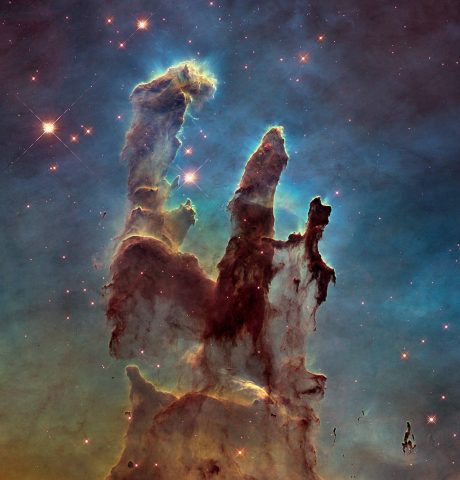
A re-image of the pillars of Creation taken by the Hubble Space Telescope in 2014. The blue color in the image represents the presence of oxygen, the red of sulfur and the green of the presence of nitrogen and hydrogen. the star clusters outside of Creation are slowly eroding the constellations of gas and dust. Ⓒ NASA, European Space Agency and Hubble Heritage Team (STScI / AURA)
The Hubble Space Telescope is a specialized instrument for observing ultraviolet and visible light with wavelengths from 0.1 to 0.8 micrometers, but it is also possible to observe using infrared wavelengths from about 0.8. to 2.5 micrometers. Below is a photo of the building column of the Hubble Space Telescope using infrared light. When this image was first released, astrophotography fans around the world described it as “Sauron” from The Lord of the Rings. It was because the shadow-like figure in the dark night sky was not pretty, but terrifying.
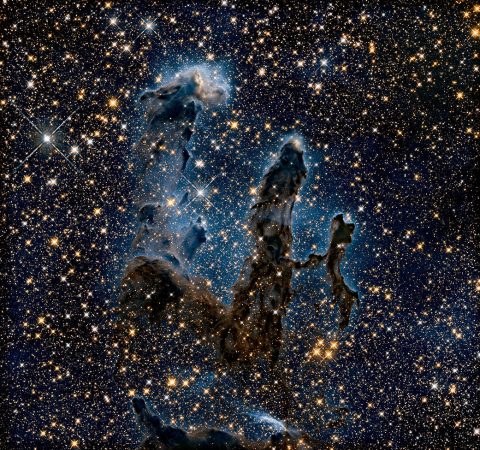
Infrared pillar of the Hubble Space Telescope building – NASA, European Space Agency and Hubble Heritage Team (STScI / AURA)
The Pillars of Creation, taken from these different telescopes, look very different. A celestial body can look very different depending on its wavelength, and the resolution of a telescope is very important for capturing detailed structures. For reference, the Pillar of Creation, which measures approximately 4-5 light years, is very small compared to the Eagle Nebula, which measures approximately 70 x 55 light years.

The pillar of creation looks very different depending on the wavelength and the resolution of the telescope is very important for capturing detailed structures. ^ European Space Agency, NASA
The Eagle Nebula, with apparent magnitude 6, can be seen using small telescopes and is best observed in July, but the well-resolved and optically resolved Pillar of Creation requires appropriate wavelengths, large telescopes, and ideal observation conditions.
Check out James Webb’s Pillars of Creation
What will the Pillars of Creation look like in the eyes of James Webb, the most sensitive and sensitive infrared space telescope ever built? James Webb never fails to photograph one of the most famous celestial bodies, the Pillars of Creation.
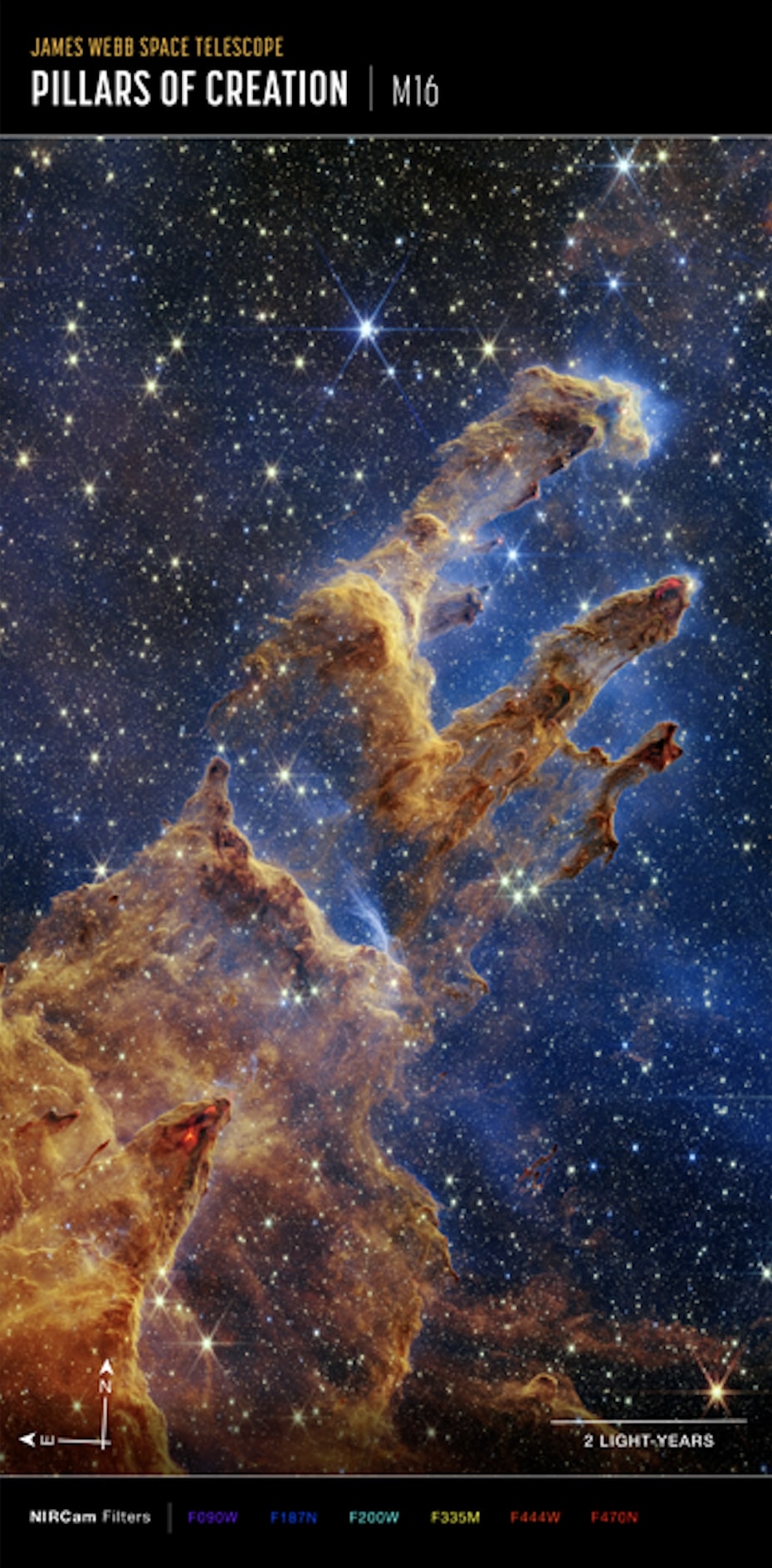
The pillars of creation are the regions where young stars are formed. Ⓒ Joseph DePasquale (STScI), Anton M. Koekemoer (STScI), Alyssa Pagan (STScI), JWST / NASA, ESA, CSA
The image above was taken with the James Webb Space Telescope’s Near Infrared Camera (NIRCam) and shows the compass arrow, scale bar and color key for reference. The north and east compass arrows show the direction when you look at the observation image from the sky to the Earth, and the direction reverses when you look at the sky from the Earth relative to that. The scale bar is expressed in light years, the distance light travels in one year and it takes two years at the speed of light to travel the scale bar. For reference, a light year is approximately 9.46 trillion kilometers. From the scale bar above, it can be seen that the field of view displayed in the image is approximately 8 light years.
This image shows the light in the near infrared wavelengths converted to visible color and the different colored filters listed below the image show the filter used to collect this light. In other words, the color used in each filter’s name represents the visible light color used to represent the infrared rays passing through that filter. (go to high resolution image) ※[참고] The image size is larger than 160 MB.
Pillars of Creation Meaning of Archery
The pillars of creation are the regions where young stars are formed. When a part of the molecular cloud begins to collapse under the influence of its own gravity, with sufficient mass, a star begins to form, which appears red with ripples. (go to high resolution image) ※[참고] The image size is larger than 150 MB.
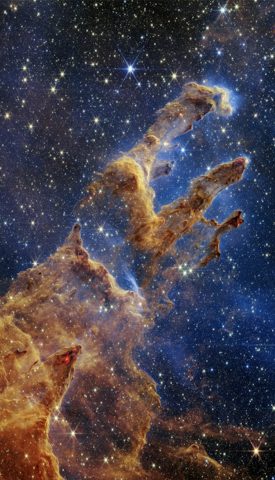
The pillars of creation are the regions where young stars are formed. Ⓒ Joseph DePasquale (STScI), Anton M. Koekemoer (STScI), Alyssa Pagan (STScI), JWST / NASA, ESA, CSA
Along the edge of the column of creation, you can see wavy lines that resemble “lava”. It is a few hundred thousand years old and interacts with gas and dust in clouds as periodic hypersonic jets from still forming stars. Sometimes they produce shock waves that form rippling patterns, like traveling down a river in a boat.
Interestingly, gases, accumulations of dust and interstellar media are effectively hampering the James Webb Space Telescope’s near-infrared observations of galaxies and universes far beyond the Pillar of Creation. In particular, the transparent layer of gas obscures our view from observations of deeper space, and the dust is also illuminated by countless stars that erupt from the Pillar of Creation. In NASA’s words, it’s like being in a brightly lit room and looking out the window. This is because the interior light bounces off the window, blocking the outside and illuminating the inside.
The Pillars of Creation, successfully captured by the James Webb Space Telescope, will help many astronomers perfect their star formation models. By determining mathematically important variables such as the amount of gas and dust in the region, identifying other objects more precisely, we can answer the astronomical question of how molecular clouds explode and form stars over millions of years.
Comparison of images taken with the Hubble Space Telescope
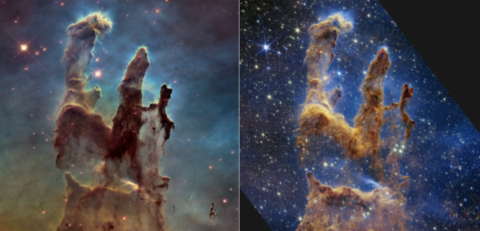
Comparison with Hubble Space Telescope imagesⓒ The Hubble Heritage Team (STScI / AURA), Joseph DePasquale (STScI), Anton M. Cucimore (STScI), Alyssa Pagan (STScI), JWST / NASA, ESA, CSA
The image on the left was taken in 2014 after the Hubble Space Telescope first photographed the Pillar of Creation in 1995. Compared to previous images, it is much brighter in visible light and reveals a wider field of view. On the other hand, the image on the right, taken by the James Webb Space Telescope, allows for a more detailed look at the dust in the star-forming region. The thick dusty plume is no longer opaque and there are even more red stars still forming here. As such, plumes of gas and dust appear darker and less transparent in images taken by the Hubble Space Telescope, but appear more transparent in images taken by the James Webb Space Telescope.
The background of the image taken by the Hubble Space Telescope resembles a sunrise. From below it becomes yellow, light green and blue, and the colors above depend on the thickness of the dust around the column, obscuring many stars around it. Conversely, near-infrared rays can penetrate through dust clouds, so images taken by the James Webb Space Telescope show more. For example, the background in the image above appears blue due to the hydrogen atoms and the details of the many stars and future stars scattered around the Pillar of Creation.
Consequently, both images show what is happening in the area of the Pillars of Creation. The Hubble Space Telescope shows the thickest dust layer and the James Webb Space Telescope shows more stars. However, in both images, dust and interstellar material, acting as haze, do not reveal much of the deeper universe.
(22)
